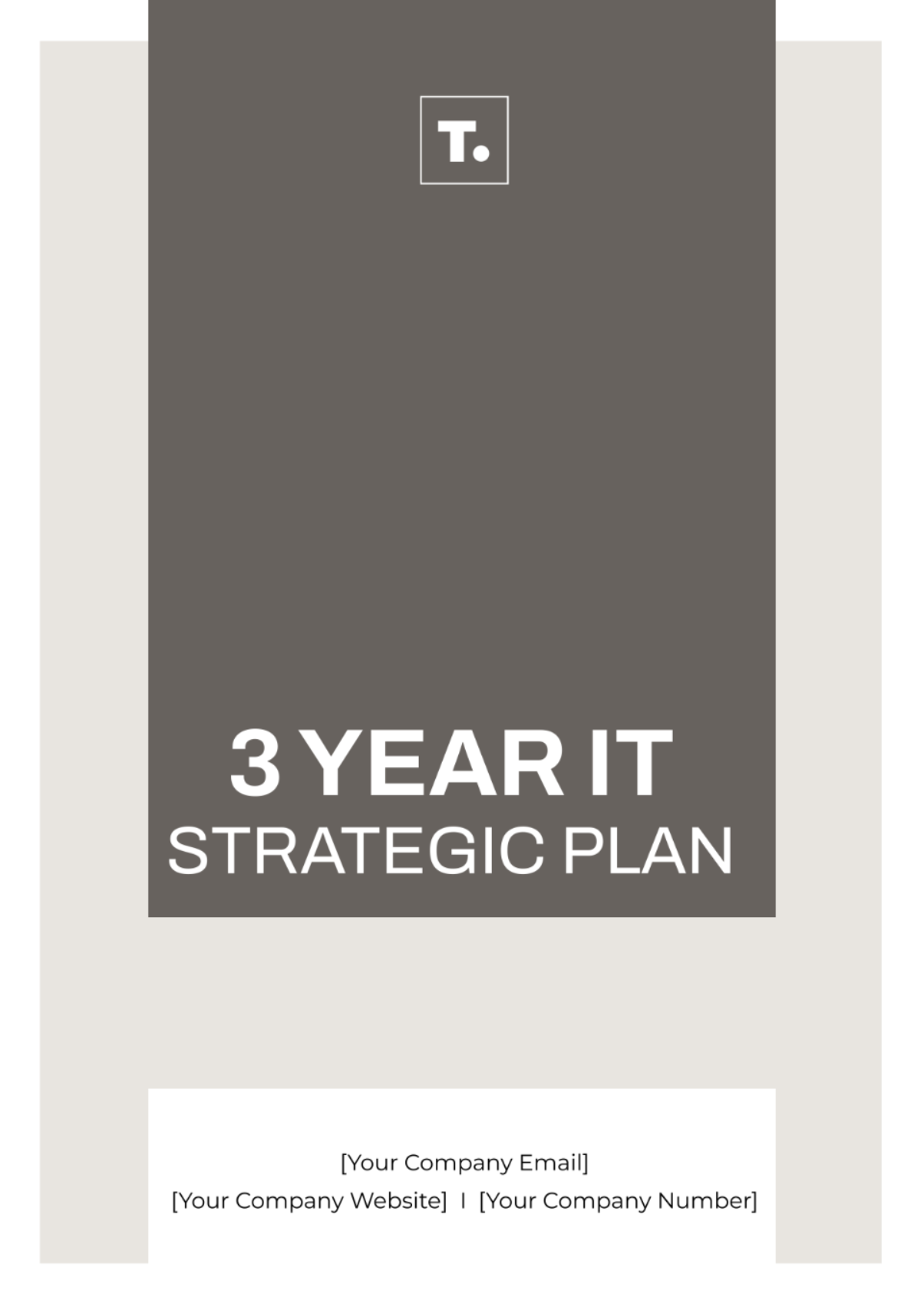Free 3 Year IT Strategic Plan

NAME | IT COMPANY | DATE |
|---|---|---|
[YOUR NAME] | [YOUR COMPANY NAME] | [DATE] |
I. Executive Summary
As [YOUR COMPANY NAME] continues to expand its presence in the digital marketplace, the IT department is tasked with spearheading initiatives to enhance technology capabilities and drive innovation. Over the next three years, our strategic plan focuses on fortifying cybersecurity, modernizing infrastructure, and fostering a culture of innovation to achieve sustainable growth and competitive advantage.
II. Strategic Analysis
[YOUR COMPANY NAME]'s IT landscape presents a blend of strengths, weaknesses, opportunities, and threats that shape our strategic direction:
Strengths |
|
Weaknesses |
|
Opportunities |
|
Threats |
|
III. Vision and Mission
Vision: To be the forefront innovator in utilizing technology to drive business success and customer satisfaction.
Mission: To deliver secure, reliable, and innovative IT solutions empowering [YOUR COMPANY NAME] to achieve strategic objectives.
IV. Goals and Objectives
Goal 1: Enhance Cybersecurity
Implement next-generation firewalls and intrusion detection systems.
Conduct regular employee cybersecurity training programs.
Goal 2: Modernize Infrastructure
Migrate legacy systems to cloud-based platforms for enhanced flexibility.
Standardize hardware and software to streamline maintenance.
Goal 3: Drive Innovation
Establish innovation labs to encourage experimentation and collaboration.
Explore AI and machine learning applications to improve business insights.
V. Resource Allocation and Budgeting
Budget Overview
Allocation Summary:
Category | Year 1 Budget ($) | Year 2 Budget ($) | Year 3 Budget ($) |
|---|---|---|---|
Hardware | $500,000 | $550,000 | $600,000 |
Software | $300,000 | $325,000 | $350,000 |
Personnel | $700,000 | $750,000 | $800,000 |
Training | $50,000 | $55,000 | $60,000 |
Total | $1,550,000 | $1,680,000 | $1,810,000 |
Notes:
Budget allocations are based on current estimates and may be subject to change based on evolving needs and priorities.
Flexibility within each category allows for adjustments based on emerging requirements or unforeseen circumstances.
Prioritization Criteria
Factors Considered for Prioritization:
Alignment with Strategic Goals: Projects that directly contribute to the achievement of organizational objectives will be given higher priority.
ROI Potential: Projects with the potential for significant return on investment (ROI) will be prioritized to maximize value for the organization.
Urgency: Projects addressing critical needs or time-sensitive requirements will be prioritized accordingly to ensure timely implementation and impact.
Risk Management
Risk Mitigation Strategies:
Contingency Budget: A portion of the overall budget will be set aside as a contingency fund to address unexpected costs or budgetary risks.
Scenario Planning: Regular risk assessments will be conducted to identify potential challenges and develop proactive mitigation strategies.
Cross-Functional Collaboration: Close collaboration between IT, finance, and other relevant departments will facilitate swift response to emerging risks and challenges.
Contingency Budget Allocation:
Contingency Budget: $200,000 per year
Total Contingency Budget (3 Years): $600,000
Notes:
Contingency funds will be allocated based on identified risks and their potential impact on project timelines and budgets.
Regular monitoring and reassessment of risks will inform adjustments to contingency plans as needed.
VI. Implementation Plan
Timeline
Phase | Timeframe | Milestones and Deliverables |
|---|---|---|
Phase 1: Analysis | Month 1 - Month 3 |
|
Phase 2: Planning | Month 4 - Month 6 |
|
Phase 3: Implementation | Month 7 - Month 24 |
|
Phase 4: Evaluation | Month 25 - Month 36 |
|
Regular progress reviews will be conducted every quarter to ensure alignment with the timeline and objectives. Adjustments to the plan will be made as necessary based on these reviews.
Responsibilities
Role | Responsibilities |
|---|---|
Chief Information Officer (CIO) |
|
IT Director/Managers |
|
IT Personnel |
|
Stakeholders |
|
Monitoring and Evaluation
Key performance indicators (KPIs) will be tracked regularly to ensure alignment with objectives and evaluate the effectiveness of implemented strategies. Some example KPIs include:
Percentage increase in network uptime
Reduction in cybersecurity incidents
User satisfaction with new software systems
Percentage of projects completed on schedule and within budget
Regular reports will be generated to track progress against these KPIs, and adjustments to the plan will be made based on the findings of these evaluations.
VII. Conclusion
The 3 Year IT Strategic Plan lays the groundwork for [YOUR COMPANY NAME]'s continued success in the digital era. By fortifying cybersecurity, modernizing infrastructure, and fostering innovation, we are poised to achieve sustainable growth and maintain our competitive edge.
- 100% Customizable, free editor
- Access 1 Million+ Templates, photo’s & graphics
- Download or share as a template
- Click and replace photos, graphics, text, backgrounds
- Resize, crop, AI write & more
- Access advanced editor
Enhance your IT strategy with our 3 Year IT Strategic Plan Template from Template.net. Tailored for efficiency, this customizable and editable template empowers your team to align objectives, anticipate challenges, and seize opportunities. With built-in AI Editor Tool, crafting a comprehensive roadmap becomes effortless. Elevate your planning process and drive sustainable growth today!





























